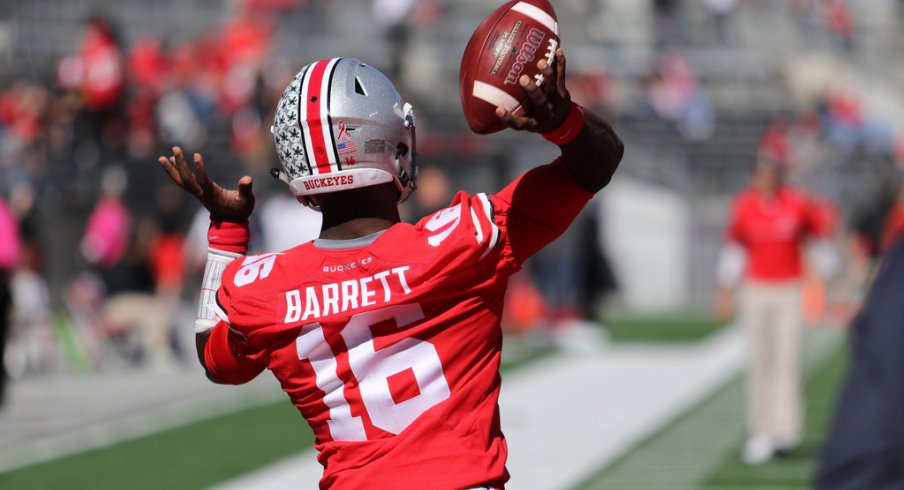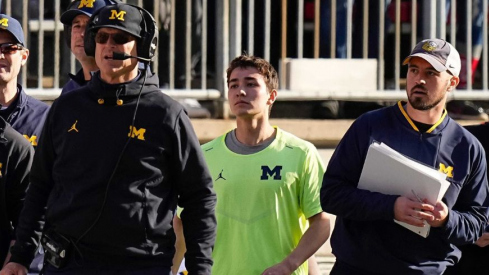After a year plagued by inconsistent performances through the air in 2015, J.T. Barrett and his Ohio State teammates started the 2016 season off with a bang. The junior quarterback found redshirt freshman receiver K.J. Hill streaking past a Bowling Green safety on only his fourth passing attempt of the afternoon for a 47-yard bomb to give the Buckeyes their first points of the new campaign.
Sensing pressure, the Buckeye captain changed the protection scheme before the snap by motioning 'H' receiver Dontre Wilson into the backfield, assuring he'd have plenty of time to let Hill's route develop downfield. There was never a question of where Barrett was throwing the ball on this particular play, as the former conference player-of-the-year recognized an opportunity to attack and set a positive tone for his third tour as Ohio State's starting quarterback.
With one flick of the shoulder, Barrett seemed to erase months of negativity and doubt, as the underperforming passing game that prevented perhaps the most talented team in school history from repeating as national champions the year prior seemed to have found its way in the offseason. All seemed well and in order for Buckeye fans that afternoon, as the single greatest offensive performance in 126 years of football was on display for the home fans in Ohio Stadium.
However, that momentum quickly faded.
Though Barrett would win his second Big Ten Quarterback-of-the-Year award, center Pat Elflein would be named the conference's best lineman, running back Mike Weber the best freshman, and Curtis Samuel would become the most dangerous skill player in the entire conference, the unit often looked much like it had the year before. Despite the efforts of Urban Meyer and his two offensive coordinators, Ed Warinner and Tim Beck, the OSU passing game once again resembled Jekyll and Hyde, leaving fans to wonder which version would show up each Saturday.
When this group was on its game, they were very good. Despite lacking a regular downfield threat through the air, Barrett remained remarkably efficient. Though he'd only break the 300-yard mark against the Falcons in week one, big efforts against Nebraska, Maryland, and Rutgers gave fans hope throughout the ensuing run to the College Football Playoff.
While the lack of a deep passing game was apparent to all, Barrett and the staff began to rely heavily on intermediate routes, specifically attacking the opposing linebackers and safeties inside along the seams. Knowing Barrett's threat as a runner would force defenses into zone coverage on nearly every play, the staff leaned most heavily on the 'H-Option' concept, isolating their best receiver, Samuel, against a lesser opponent and allowing him to work.
Warinner, the lead play-caller, dialed up this concept more than any other last fall, watching from above as his All-American 'H' receiver easily led the team with 74 catches for 865 yards. After Wisconsin and Penn State showed that the clamps could easily be put on the Buckeyes' outside receivers, Samuel and Barrett found other ways to attack defenses along the interior.
The Buckeyes regularly called various 'Spacing' concept variations, stretching the four underneath zones of the defense with five routes and giving Barrett a quick read to get the ball out.
Samuel wasn't the only one to benefit from Warinner's reliance on quick-hitting underneath routes. Tight end Marcus Baugh hauled in 24 passes last fall, 17 of which came in the second half of the season as opponents grew wise to the constant threat posed by Samuel.
But while the intermediate routes above were the most commonly run, they weren't the most dangerous.
That honor goes to the varying ways the Buckeye staff dialed up three-man 'flood' concepts to one side, giving Barrett an easy deep-to-short read on one side of the field. More often than not, the deep 'go' route cleared space for the middle route to come open, giving Barrett the opportunity to pick up a big chunk of yardage quickly.
The staff did an excellent job disguising the concept from week-to-week, sometimes building off play-action and using either a tight end or running back on the short 'flat' route underneath. Additionally, the middle route could come from either side of the formation, with the call being either the 'Y-Cross' or the 'Sail' concept while giving Barrett the same read either way.
But though the lack of a true downfield target has been missing in Columbus since Devin Smith departed for the NFL after the 2014 season, it's not as if the Buckeyes had no downfield passing game to speak of. Samuel caught eight passes of 20 yards or more and Hill showed promise in limited playing time.
While Smith simply used pure speed to gain separation against defenders, there are ways to scheme a receiver open, and Warinner and Beck were, despite popular opinion, able to do just that on a few occasions.
Given the success Michigan State has found against Meyer's Buckeye offense with their 'Quarters' scheme over the years, many have opponents have tried to duplicate that success by regularly running that coverage themselves. By attacking with three vertical routes that effectively force safeties into playing man coverage downfield, the Buckeyes were still able to pick up big yardage against these looks.
In addition to 'Quarters,' the Buckeyes saw plenty of 'Cover-3' last fall, especially after Penn State held OSU to a measly 5.7 yards-per-attempt in their upset victory in October. At the time it seemed that Barrett had nowhere to go downfield, but in the following weeks, he and the receiving crew bounced back with resolve, attacking the soft spots in that scheme to get the ball in the hands of their playmakers.
With so much focus on the deep passing game, it was easy to overlook how efficient the Buckeyes had become through the air once they reached the red zone. Barrett was at his best in this compressed space, using his legs to keep defenders on their heels and finding the end zone 12 times, a total unmatched in the Big Ten.
While much of the credit in this area of the field goes to Noah Brown and his ability to use his massive frame to simply overpower defenders, like he did on the road in big wins over Oklahoma and Wisconsin, Warinner and Beck did an excellent job of creating space for their receivers near the goal line with natural picks.
While nothing is ever as bad as it might seem at the time, it's also never as good, either. Even in that record-setting game against Bowling Green, Barrett's second attempt was intercepted and nearly returned for a score. Although the concepts shown above were quite successful at times throughout the 2016 season, they were also contained well by the talented defenses of Michigan, Michigan State, Penn State, and Clemson, but also by less-heralded units from Indiana and Tulsa.
Though Warinner and Beck have since moved on to other coaching staffs and their replacement, former Indiana head coach Kevin Wilson, will surely add some wrinkles of his own to the playbook, this is still Meyer's offense. Fans expecting a massive overhaul may be disappointed. For Barrett to improve in his final season under center, he and his teammates have some work to do from both an execution and a schematic standpoint (which we'll detail in this space next week).
But make no mistake, the 2016 Buckeye offense was still dangerous. As long as Ohio State has been playing football, only Bobby Hoying in 1995, Joe Germaine in 1998, Troy Smith in 2006, Terrelle Pryor in 2010, Braxton Miller in 2013, and Barrett himself in 2014 turned in better quarterback performances over the course of a season in scarlet and gray than the one we just witnessed.
Though the game has certainly changed and teams are throwing the ball more than ever, it's easy to discount what the numbers might say. However, for the Buckeyes to get back to the championship level of 2014 they aren't as far away as it might seem.



